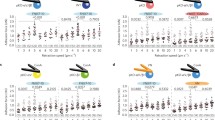Abstract
Using specific recombinant human fibronectin peptide (hFNIII9-10) that contains the binding site for integrin, we found that the fibroblast growth factor, FGF-2, enhances fibronectin-mediated adhesion in human osteoblast-like MG63 cells. The mechanism of the synergistic adhesion was due to the activation of extracellular-regulated kinase (ERK)-type MAPK upon interaction of integrin to hFNIII9-10 and its downstream activation of signaling pathways.
Similar content being viewed by others
References
Almeida EA, Ilic D, Han Q, Hauck CR, Jin F, Kawakatsu H, Schlaepfer DD, Damsky CH (2000) Matrix survival signaling: from fibronectin via focal adhesion kinase to c-Jun NH(2)-terminal kinase. J. Cell Biol. 149: 741-754.
Aota S, Nomizu M, Yamada KM (1994) The short amino acid sequence Pro-His-Ser-Arg-Asn in human fibronectin enhances cell-adhesive function. J. Biol. Chem. 269: 24756-24761.
Calderwood DA, Shattil SJ, Ginsberg MH (2000) Integrins and actin filaments: reciprocal regulation of cell adhesion and signaling. J. Biol. Chem. 275: 22607-22610.
Choquet D, Felsenfeld DP, Sheetz MP (1997) Extracellular matrix rigidity causes strengthening of integrin-cytoskeleton linkages. Cell 88: 39-48.
Meyers GA, Orlow SJ, Munro IR, Przylepa KA, Jabs EW (1995) Fibroblast growth factor receptor 3 (FGFR3) transmembrane mutation in Crouzon syndrome with Acanthosis nigricans. Nat. Genet. 11: 462-464.
Nagai H, Tsukuda R, Mayahara H (1995) Effects of basic fibroblast growth factor (bFGF) on bone formation in growing rats. Bone 16: 367-373.
Powers CJ, McLeskey SW, Wellstein A (2000) Fibroblast growth factors, their receptors and signaling. Endocr. Relat. Cancer 7: 165-197.
Ruoslahti E, Pierschbacher MD (1987) New perspectives in cell adhesion: RGD and integrins. Science 238: 491-497.
Author information
Authors and Affiliations
Rights and permissions
About this article
Cite this article
Jang, JH., Ku, Y., Chung, CP. et al. Enhanced fibronectin-mediated cell adhesion of human osteoblast by fibroblast growth factor, FGF-2. Biotechnology Letters 24, 1659–1663 (2002). https://doi.org/10.1023/A:1020617904251
Issue Date:
DOI: https://doi.org/10.1023/A:1020617904251




